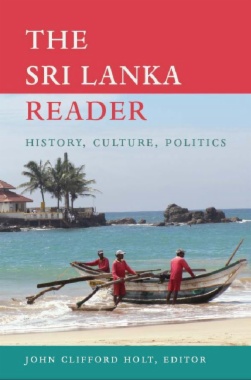The Sri Lanka Reader is a sweeping introduction to the epic history of the island nation located just off the southern tip of India. The island’s recorded history of more than two and a half millennia encompasses waves of immigration from the South Asian subcontinent, the formation of Sinhala Buddhist and Tamil Hindu civilizations, the arrival of Arab Muslim traders, and European colonization by the Portuguese, then the Dutch, and finally the British. Selected texts depict perceptions of the country’s multiple linguistic and religious communities, as well as its political travails after independence in 1948, especially the ethnic violence that recurred from the 1950s until 2009, when the Liberation Tigers of Tamil Eelam were defeated by the Sri Lankan government’s armed forces. This wide-ranging anthology covers the aboriginal Veddhas, the earliest known inhabitants of the island; the Kings of Kandy, Sri Lanka’s last indigenous dynasty; twenty-first-century women who leave the island to work as housemaids in the Middle East; the forty thousand Sri Lankans killed by the tsunami in December 2004; and, through cutting-edge journalism and heart-wrenching poetry, the protracted violence that has scarred the country’s contemporary political history. Along with fifty-four images of paintings, sculptures, and architecture, The Sri Lanka Reader includes more than ninety classic and contemporary texts written by Sri Lankans and foreigners.
- Contents
- List of Illustrations
- Acknowledgments
- Introduction
- I. From Ancient to Early Modern
- Buddhist Visions of a Primordial Past
- A Tamil Hindu Vijaya: Yalpana Vaipava Malai
- The Saga of Dutugemunu
- Sirisamghabodhi and the Ideals of Buddhist Kingship
- Anuradhapura: Fifth-Century Observations by a Chinese Buddhist Monk
- Path of Purification
- A Hydraulic Civilization
- Sigiri Graffiti
- Set in Stone
- Anuradhapura: A Photographic Essay
- The Indigenous Veddhas
- Tamil Identity in Ancient Sri Lanka
- Promulgations of a Polonnaruva King
- Tamilnadus in Rajarata
- Buddhist Sculpture at Polonnaruva: A Photographic Essay
- The Abdication of King Parakramabahu II
- Dambadeni Asna
- Alakeshvara Yuddhaya
- The Observations of Ibn Battuta
- Saelalihini Sandesaya (The Starling’s Message)
- II. The Colonial Encounter
- Sri Lanka: National Identity and the Impact of Colonialism
- The Portuguese: An Introduction
- An Early Observer
- Visions from the Mid-Sixteenth Century: The Economist, the Viceroy, and the Missionary
- The Spin Doctors at Work: The Island as “New Portugal”
- Kandy in the 1630s: Through the Eyes of a Soldier-Poet and a Soldier-Ethnographer
- The Final Dreamers
- The Catholics’ Last Sigh: Oratorian Missionaries in Eighteenth-Century Kandy
- The Dutch: An Introduction
- A Dutch Prelude
- Jaffna and Kandy through Eyes of a Dutch Reformed
- The Price of Good Cinnamon
- How the Dutch Ruled
- Dutch Policy towards Buddhism in Sri Lanka
- The British: An Introduction
- A British Description of Colombo, 1807
- The Final Tragedy of the Kandyan Kingdom
- The Rebellion of 1818 and Consolidation of British Rule
- The 1848 Rebellion
- Leonard Woolf’s Ceylon
- The Establishment of the Tea Industry in Ceylon
- Kandyan Culture in the Colonial Era: An Introduction
- Vimaladharmasurya: The First Kandyan King
- Concerning Their Religions . . .
- Poetry and Proclamations in the Kandyan Kingdom
- An Open Letter to the Kandyan Chiefs
- Colonial Postscript: The Other Eden
- III Emerging Identities
- Buddhist Identities: An Introduction
- Old Diary Leaves
- The Western Invasion and the Decline of Buddhism
- Ape Gama (Our Village)
- Ten-Precept Mothers in the Buddhist Revival in Sri Lanka
- Sarvodaya in a Buddhist Society
- Politically Engaged Militant Monks
- Politics of the Jathika Hela Urumaya: Buddhism and Ethnicity
- A Buddha Now and Then: Images of a Sri Lankan Culture Hero
- Losing the Way Home
- Muslim Identities: An Introduction
- Origins of the Sri Lankan Muslims and Varieties of the Muslim Identity
- The Ethnology of the “Moors” of Ceylon
- A Criticism of Mr. Ramanathan’s “Ethnology of the Moors of Ceylon,”
- Who Are the Moors of Ceylon?
- The Bawas of Ceylon
- The Fight for the Fez
- The Purdah’s Lament
- Sri Lankan Malays
- Tamil Identities: An Introduction
- Language, Poetry, Culture, and Tamil Nationalism
- The Dance of the Turkey Cock—The Jaffna Boycott of 1931
- Language and the Rise of Tamil Separatism in Sri Lanka
- The Militarisation of Tamil Youth
- Womanhood and the Tamil Refugee
- Translating Remembering
- Nallur
- Christians in a Buddhist Majority
- Christians and Burghers: An Introduction
- On the Meaning of “Parangi” and “Burgher”: Symbolic Discourse of Subordination
- Emergent Perspectives in Modern Art: The ’43 Group—Formation of a Sri Lankan Avant-Garde
- IV. Independence, Insurrections, and Social Change
- Sri Lanka in 1948
- The Bandaranaike Legend
- After Forty-Five Years
- The Ceylon Insurrection of 1971
- The Colombo Riots of 1983
- “In the Month of July” and “Voyagers”
- Patriotic TV
- Search My Mind
- The Great Divide
- A Land Divided
- Neither Sinhala nor Tamil—On Being a South Asian in Sri Lanka
- Female Labor Migration from Sri Lanka to the Middle East
- Juki Girls: Gender, Globalization, and the Stigma of Garment Factory Work
- A Place with No Room
- The Wave
- V. Political Epilogue
- And Then They Came for Me
- Checkmate!
- Our Holocaust
- Moderation the Only Way
- Kingship-in-the-Making
- Acknowledgment of Copyrights and Sources
- Suggestions for Further Reading
- Index

